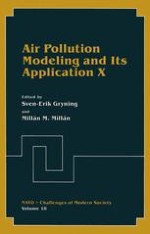1994 | OriginalPaper | Chapter
Fluxes over Complex Terrain, Analytical Evaluation
Authors : G. A. Dalu, M. Baldi, R. A. Pielke, G. Kallos
Published in: Air Pollution Modeling and Its Application X
Publisher: Springer US
Included in: Professional Book Archive
Activate our intelligent search to find suitable subject content or patents.
Select sections of text to find matching patents with Artificial Intelligence. powered by
Select sections of text to find additional relevant content using AI-assisted search. powered by
It is long been recognized that land and sea contrasts produce sea breezes. More recently, it has become evident that landscape variations which result in spatial gradients in surface heat flux can produce mesoscale circulations as strong as sea breezes. However, it remains to determine how small a horizontal variation in surface heating can still produce a significant mesoscale circulation. It order to address this question, in this paper we present results for one Fourier component. While only the linear response can be evaluated using this tool, such models have been shown to be effective at identifying dominant physical processes associated with sea breezes (Rotunno, 1983; Dalu and Pielke, 1989, 93). This approach can also be used to assist in the development of a parameterization of mesoscale effects generated by spatial surface sensible heat variability for use in larger scale models. The primitive equations can be reduced to an equation for the streamfunction: 1$$\left[ {{{\left({\frac{\partial }{{\partial x}} + {k_p}} \right)}^2} + k_o^2} \right]\frac{{{\partial ^2}\varphi }}{{\partial {z^2}}} + \left[ {{{\left( {\frac{\partial }{{\partial x}} + {k_p}} \right)}^2} + {l^2}} \right]\frac{{{\partial ^2}\varphi }}{{\partial {x^2}}} = - \frac{1}{{{U^2}}}\frac{{\partial Q}}{{\partial x}}$$2$$\begin{gathered}\frac{{\partial \varphi }}{{\partial z}} = u {\text{and}} \frac{{\partial \varphi }}{{\partial x}} = - w; {l^2} = \frac{{N_o^2}}{{{U^2}}} - \frac{{{U_{zz}}}}{U}; p = s + \lambda ; {k_p} = \frac{p}{U} + \frac{{K{k^2}}}{U} {\text{and}} {k_o} = \frac{f}{U} \hfill \\h = {h_o}\frac{1}{2}\left[ {1 + {a_1}\sin \left( {kx} \right) + {a_2}\cos \left( {kx} \right)} \right] = {h_o}\frac{1}{2}\left[ {1 + a\sin \left( {kx + b} \right)} \right] \hfill \\\end{gathered}$$3$${a_1} = \frac{{\lambda \left( {\lambda + K{k^2}} \right)}}{{{{\left( {\lambda + K{k^2}} \right)}^2} + {k^2}{U^2}}}; {a_2} = - \frac{{\lambda kU}}{{{{\left( {\lambda + K{k^2}} \right)}^2} + {k^2}{U^2}}}; \mathop {\lim }\limits_{k,U \to \infty } {a_1},{a_2} = 0$$4$${h_a} = \frac{1}{2}{h_o}\left( {1 + a} \right) Q = \frac{{{Q_o}q\left( s \right)}}{2}\left[ {1 + a\sin \left( {kx + b} \right)} \right]He\left( {{h_a} - z} \right)$$
